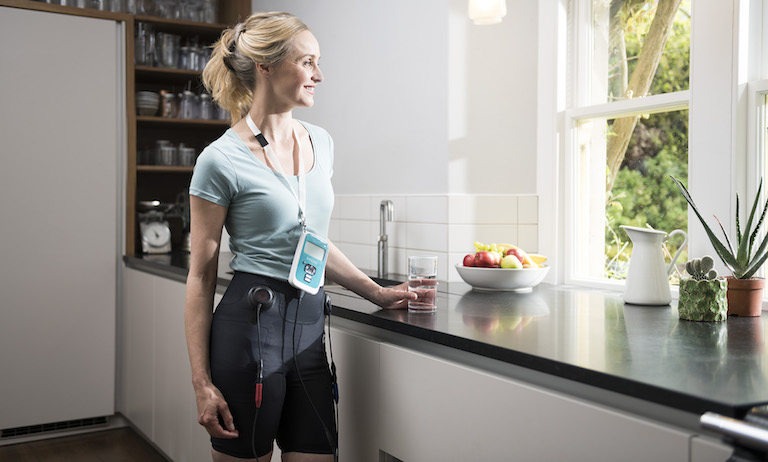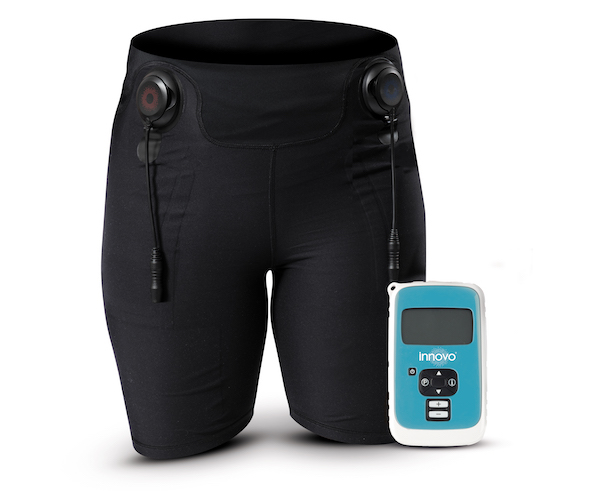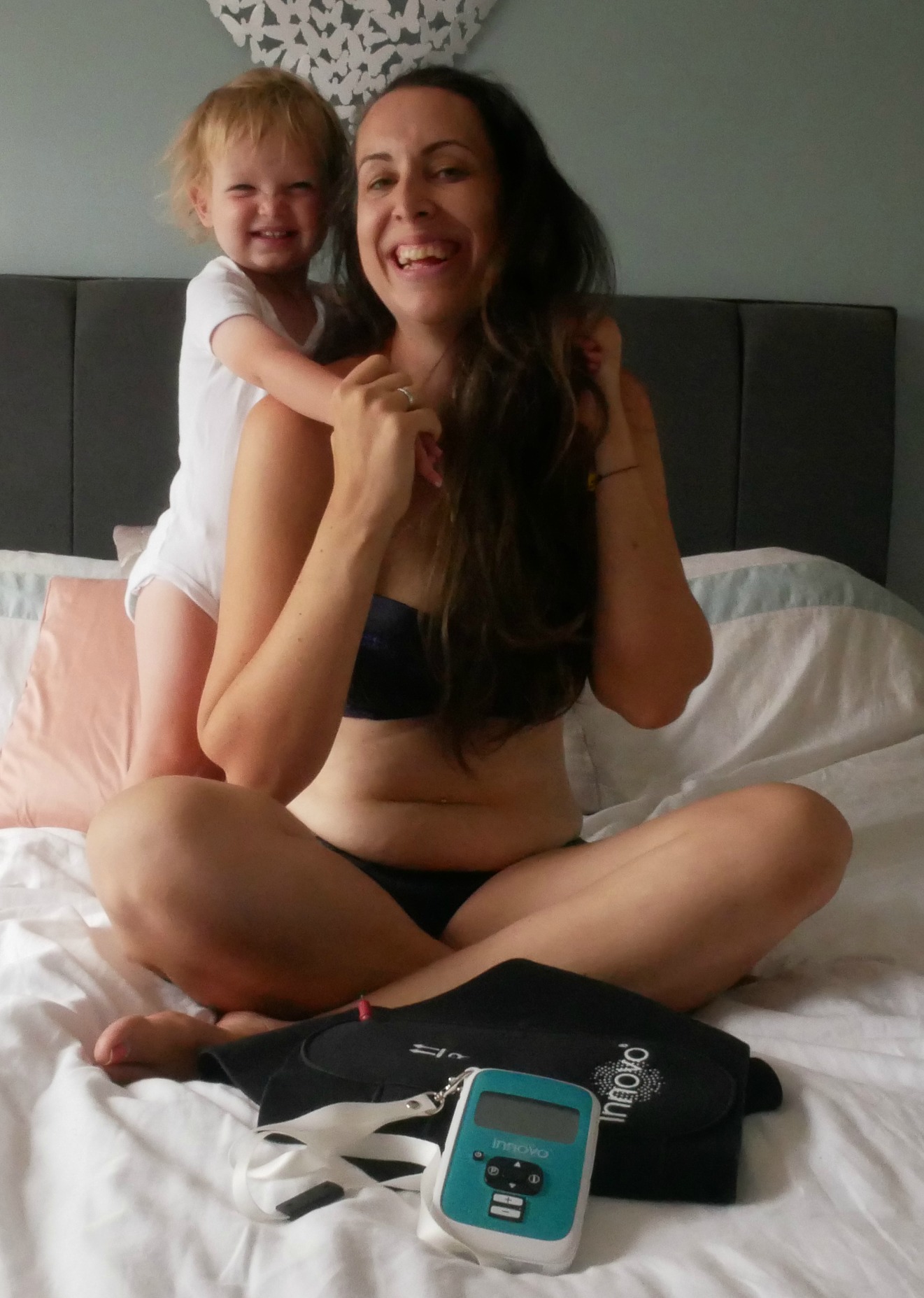Urinary incontinence affects one in three women in Britain, but a new pair of shorts – the first non-invasive at-home treatment proven to strengthen the pelvic floor – is set to change that.
A plethora of gadgets – including at least two apps – have recently hit the UK claiming to strengthen our pelvic floors and help prevent or even treat bladder leakage or incontinence problems, often as a result of childbirth but also during the menopause.
The problem is they’re all invasive; they all need to go inside the vagina to work, which increases the risk of infections according to some studies (14%).
The new INNOVO® Shorts look a lot like the cycle shorts Kylie Jenner wears out dancing, there’s nothing to insert but they function as a pelvic floor toner and treatment for bladder leakage, weak bladder or incontinence.
Indeed, in research on 19 women who had urinary incontinence, 86 per cent were dry or almost dry after 12 weeks using the shorts.
The research, presented at the 2018 Urogynaecological Association’s Annual General Meeting in June also found a staggering 93 per cent of users saw a significant reduction in urinary leaks in just four weeks, after wearing the shorts for five 30-minute sessions a week.
How the new pelvic floor-strengthening shorts work
Everyone knows they should be doing their pelvic floor or Kegel’s exercises before and after childbirth as well as when we get older and in the lead up to menopause.
Your pelvic floor muscles are located deep inside your core, from your vagina to your anus and they support your urethra, which is the tube that empties urine, and your bladder. When they’re weak, your bladder too gets weak.
But pelvic floor exercises can be complicated because it can be hard to find and use those muscles, says Jane Wake, a fitness expert and personal trainer specialising in post-natal exercise.
The patented technology in the Innovo shorts, called ‘Multipath’ stimulates and contracts the pelvic floor for you.
‘Your pelvic floor muscle is like any other muscle in the body, it is supposed to contract but it’s also supposed to lengthen,’ says Wake. ‘When you have a weakness in the pelvic floor, it can be tight and have areas that aren’t functioning properly and that can make those muscles hard to locate, let alone squeeze, the way you’re supposed to whilst doing pelvic floor exercise.’
‘What’s more, most women who have had a baby often can’t feel anything in their pelvic floor, so doing pelvic floor exercises themselves can be virtually impossible’. In fact, studies have shown that 50% of women cannot manually activate their pelvic floor properly.
This is where the shorts come in, they do the work of exercising for you, identifying and stimulating the pelvic floor muscles effectively and effortlessly.
But how can something you simply wear, function to strengthen muscles that are inside you?
The patented technology in the shorts, called ‘Multipath’ stimulates and contracts the pelvic floor muscles for you.
This is done through a network of conductive panels contained within the shorts. ‘These panels send muscle stimulations across your pelvic floor, generating a strengthening and training effect with regular use,’ says Wake.
You spray the conductive panels on the shorts (there are eight) and put the shorts on. Then you take a self-controlled hand-held device – about the size of small remote control – and start one of two programmes; one designed for strengthening the pelvic floor and treating Stress Urinary Incontinence and the second for treating Urge Incontinence (see below for what’s what).
If you’re one of the many women who have mixed incontinence – both stress and urge – you can alternate between the programmes.
‘When you use INNOVO®, you can feel your pelvic floor lift, tighten and then drop, which is the exact movement you should be making in doing your pelvic floor exercises,’ says Jane Wake.
‘For women who find the exercises too complicated or can’t feel their muscles at all, say after childbirth, this can be just the impetus they need to strengthen their pelvic floor and understand how the correct contraction of the muscles feels.’
Urinary incontinence – which type have you got?
There are two different types of weakened bladder problems. Stress incontinence is the most common, which is caused by a weakened pelvic floor. It’s that thing where you get a little (or a lot of) leakage of wee when coughing, laughing, sneezing, exercising, or lifting objects.
The other type is called Urge Incontinence. ‘That’s the key in the door moment when you get to the door and you think you can control your urge to go until to get to the loo, but you can’t and you get leakage,’ says Wake. ‘This is also the pelvic floor not functioning properly as a result again of weakened muscles.’
There are a number of reasons women’s pelvic floors become weaker, says Wake.
‘Post-natally, many women lose their pelvic floor strength because of the strains of childbirth,’ says Wake.
‘New mums need to be exercising yes, but in specific ways, otherwise they may end up with a weakened pelvic floor up to a year more later.’
Urinary incontinence is common during the perimenopause too – that’s the decade preceding menopause which for most women is in their 40s – and may worsen during menopause, which the average British woman experiences at around 52.
In the lead up to menopause, lowered oestrogen levels can cause a decrease in the production of collagen that keeps skin firm, leading to vaginal tissue becoming less elastic. At the same time, the lining of your urethra, the tube that empties urine from your bladder, begins to thin.
‘Women who exercise a lot may have problems with a weakened pelvic floor’, says Wake.
‘The trend for heavy weight training can also cause this, because of the weight placed on the pelvic floor muscles during big moves such as deadlifts and squats, along with running and other forms of high impact exercise.
‘The downward pressure that such exercise puts on the pelvic floor can aggravate the muscles.
‘Moreover, many new mums jump straight back into their pre-baby exercise routines without knowing exactly what exercises to be doing to get their pelvic floor back in shape again,’ Wake asserts.
‘New mums need to be exercising yes, but in specific ways, otherwise they may end up with a weakened pelvic floor up to a year more later.’
Here’s a tutorial on how to set up and use the shorts
‘The shorts that helped my post-baby urinary incontinence’
Katy (above) is a blogger who runs whatkatysaid.com and lives in Hertfordshire with her husband and three children who are all under six
‘In hindsight, having had three babies in quick succession must have put a lot of pressure on my pelvic floor.
‘After my first two I was really smug because I didn’t have any issues and thought to myself: ‘Well I know I didn’t bother to do my Kegel’s but look at me I don’t have any issues.
‘I found doing the exercises really difficult – you have to really concentrate and focus on what you’re doing and it was just another thing I had to think about, so I didn’t do them.
‘Then, after baby number three I wasn’t so smug because it was then I realised that ‘Oh right, I probably should have done more pelvic floor exercises before my pregnancies.
‘The embarrassment of having a weak bladder was awful. After my third baby it would get to the end of the day and I would get undressed and find that I was secretly pushing my underwear to the bottom of the laundry pile so my husband wouldn’t see it and ask me what had happened there.
‘That was every day – every single day.
‘For the last year I had been going to exercise classes and there is one particular stretch that you do at the beginning of the exercise session and at the end where you do a sideways lunge downwards. Each time, that would result in leakage for me.
‘I didn’t know what to do and simply thought ‘Oh, I will have to start wearing pads now – but that’s what 90-year olds do.’
‘I thought to myself, ‘I’m having pelvic floor problems and if I don’t stand up and admit I have a problem – especially as a mummy blogger – how can I help my readers who are experiencing the same thing?
‘So, when INNOVO® contacted me to do a trial of their new shorts, despite my reluctance, I said yes.
‘I did the 12-week programme from May to July and by August I didn’t have a problem anymore, I can go to my exercise class and I can do my sideways lunge and I don’t have to worry. It’s so easy, I don’t have to concentrate on doing my pelvic floor exercises because the shorts do them for me.
‘I could just put them on, do my work or watch a movie, sit and relax while it was happening and I didn’t have to think about it.
‘I’m lazy, I have things to think about with three children and I haven’t got the brain capacity to think about squeezing my pelvic floor so if I can put something on that does it for me, it’s a huge time-saver.
‘I know it would have gotten worse over time if I hadn’t done this, so I would encourage new mums to get started on it sooner, rather than later.’
INNOVO® Shorts cost £249 or £41,5 per month in 6 monthly instalments from restorethefloor.com
Related Healthista Content
Is it normal to pee when I laugh?
It burns when I pee. What now?
15 minute post-natal Pilates workout to tighten a post-baby tummy
How I overcame my post natal depression
Like this article? Sign up to our newsletter to get more articles like this delivered straight to your inbox.
























































